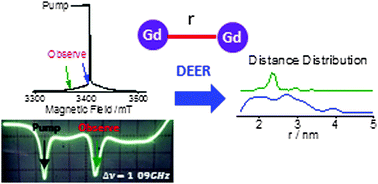Overcoming artificial broadening in Gd3+–Gd3+ distance distributions arising from dipolar pseudo-secular terms in DEER experiments†
Abstract
By providing accurate distance measurements between spin labels site-specifically attached to bio-macromolecules, double electron–electron resonance (DEER) spectroscopy provides a unique tool to probe the structural and conformational changes in these molecules. Gd3+-tags present an important family of spin-labels for such purposes, as they feature high chemical stability and high sensitivity in high-field DEER measurements. The high sensitivity of the Gd3+ ion is associated with its high spin (S = 7/2) and small zero field splitting (ZFS), resulting in a narrow spectral width of its central transition at high fields. However, under the conditions of short distances and exceptionally small ZFS, the weak coupling approximation, which is essential for straightforward DEER data analysis, becomes invalid and the pseudo-secular terms of the dipolar Hamiltonian can no longer be ignored. This work further explores the effects of pseudo-secular terms on Gd3+–Gd3+ DEER measurements using a specifically designed ruler molecule; a rigid bis-Gd3+-DOTA model compound with an expected Gd3+–Gd3+ distance of 2.35 nm and a very narrow central transition at the W-band (95 GHz). We show that the DEER dipolar modulations are damped under the standard W-band DEER measurement conditions with a frequency separation, Δν, of 100 MHz between the pump and observe pulses. Consequently, the DEER spectrum deviates considerably from the expected Pake pattern. We show that the Pake pattern and the associated dipolar modulations can be restored with the aid of a dual mode cavity by increasing Δν from 100 MHz to 1.09 GHz, allowing for a straightforward measurement of a Gd3+–Gd3+ distance of 2.35 nm. The increase in Δν increases the contribution of the |−5/2〉 → |−3/2〉 and |−7/2〉 → |−5/2〉 transitions to the signal at the expense of the |−3/2 〉 → |−1/2〉 transition, thus minimizing the effect of dipolar pseudo-secular terms and restoring the validity of the weak coupling approximation. We apply this approach to the A93C/N140C mutant of T4 lysozyme labeled with two different Gd3+ tags that have narrow central transitions and show that even for a distance of 4 nm there is still a significant (about two-fold) broadening that is removed by increasing Δν to 636 MHz and 898 MHz.


 Please wait while we load your content...
Please wait while we load your content...